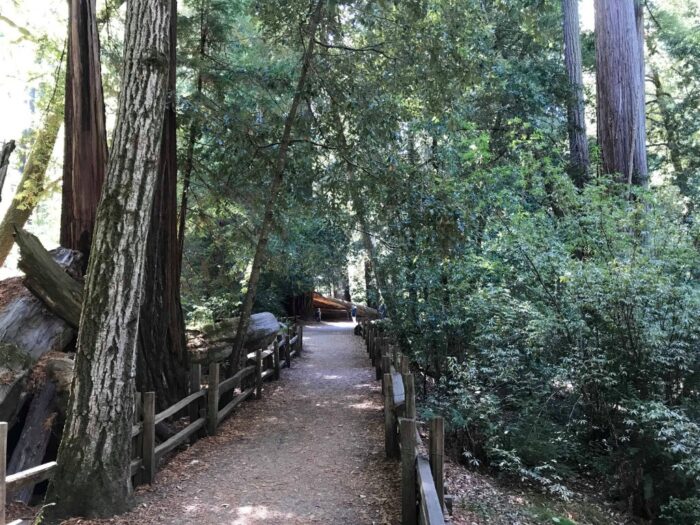We might not have known much about Californian nature beforehand, but we had heard about the redwoods. After our crazy day trip to Yosemite a few days earlier with Stephanie, it was time to meet up with her once more for new adventures. This time it was a visit to the giant trees at the Big Basin Redwood State Park that was on the agenda.
Lying in the mountains between San Francisco and Santa Cruz, the Big Basin Redwood State Park is home to some spectacular trees.


Driving to Big Basin
Stephanie picked us up in Livermore and we were soon on our way south towards San Jose and the Big Basin Redwood State Park.
Once having passed San Jose, the freeway was replaced with the mountain roads crisscrossing the area. It didn’t take long before Susann felt ill. Luckily, she was able to survive the rest of the drive but dreaded the thought of taking the same road back.
It is possible to enter the park with a vehicle after paying a small entrance fee (10 USD). Once inside, we parked the car and headed out to explore one of the many trails.





Big Basin Redwoods State Park
Big Basin Redwoods State Park is the oldest state park in California. It was established in 1902 after the state purchased the land from the Maddock family. The family was the first one to settle here in 1882. The park was originally 15 km2 but has increased to over 73 km2. It is home to the Ancient Coast Redwoods, which dominate the park. In fact, it is the largest uninterrupted area with these giants.
The Coastal Redwoods can reach 115 meters and the circumference can be about 15 meters. With bark up to 30 centimeters thick, the trees have strong protection against the many forest fires that are destined to haunt the area during its lifetime. Especially since the Redwood can live for 1.200 to 1.800 years, or even more.
What’s fascinating is that the trees reproduce in two ways. Both with seeds and by sprouting of new trees from the roots or even from falling branches. This creates two interesting formations of the trees, either in a circle around the “parent” or in a straight line along a previously fallen tree.



A Guided Tour of the Redwood Loop and a hike to Sempervirens Falls
After parking the car and asking for advice at the park headquarters we realized how lucky we were. A small group of people was just gathering around the guide Barry Grimm for a free guided hike. The hike was split into two sections, the first short walk around the loop trail and later the little more challenging hike to Sempervirens Falls.
The group got quite big in the last minutes and we were around 15 people walking along the trail of the short Redwood Loop. This short trail introduces some of the more famous trees in the park. The first one was the Father of the Forest, with a height of 76 meters (250 feet) and a circumference of over 2 meters (66 feet) at the ground. Secondly, soon afterward, we saw the Mother of the Forest with a height of 89 meters (293 feet) and a circumference of of 2.1 meters (70 feet). The Mother, however, used to stand 100 meters (329 feet) tall.
We also got to see the effect fires have on these trees. Especially how protective their bark is. When forest fires have destroyed most of the Douglas-fir (another giant found in the forest), most Redwoods still stand. Even with severe fire damage the trees have survived and adapted to a new life. Even a tree turned into a chimney by the fire, with its top burned off and a hole all the way down, can survive. Seeing these giant caves is impressive and it is sometimes hard to imagine that the trees are still standing.
After leaving a big part of the group back at the park headquarters, we soon set out on the longer hike towards the Sempervirens fall. I believe that we started along the Skyline to the Sea Trail before turning of and following the Sequoia Trail back by the falls towards the Park Headquarters.
The trail took us along several more Redwoods, but also the cabin of the Maddock Family. As mentioned earlier, this family was in 1882 the first settler of Big Basin and lived there for seven years. The State of California purchased the land in 1902 from the Maddock family and it then became the state’s first state park.
The hike eventually took us by the Slippery Rock and down to the Sempervirens fall. The fall itself is quite small, but the whole area is green and beautiful. It is somewhat peaceful to walk around in nature and it was a great surprise that it was so peaceful, with the whole Bay Area so close by.
About two hours after leaving the park headquarters we were back and getting ready to leave Big Basin. To Susann’s delight, we were about to take an easier road out.



A Evening Stroll in Santa Cruz
Instead of heading directly back to Livermore, the three of us decided to extend the adventure with a short stop in Santa Cruz. Located just a short drive away we got to see the Pacific once more. This time, we had to get a better view than during our visit to the Golden Gate Bridge in San Francisco.
While enjoying the sunset from the Santa Cruz Wharf we also got to see the sea lions again. This time they were resting on the big pieces of wood that were holding the wharf together. Which made it possible to get even closer to them than on Pier 39, but still on a safe distance a few meters above them. Santa Cruz really seemed a lot more lively than anything we had seen so far in North America, probably due to the amusement park located on the beach. Each city really has its own vibe here.
Sadly it was getting dark and we decided to head back to Pleasanton and Livermore for some Mexican food. This was our last full day in North America and we were going to board the flight back to Europe the next day.




Read more about our adventure in North America here >>






